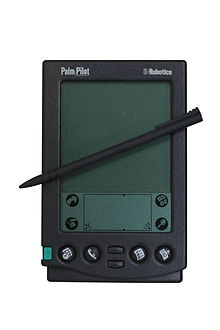Loading AI tools
Handheld personal information manager From Wikipedia, the free encyclopedia
The PalmPilot Personal and PalmPilot Professional are the second generation of Palm PDA devices produced by Palm Inc (then a subsidiary of U.S. Robotics, later 3Com). These devices were launched on March 10, 1996.
 PalmPilot with stylus | |
| Manufacturer | Palm Inc (then a subsidiary of U.S. Robotics) |
|---|---|
| Type | Bar PDA |
| Release date | March 10, 1996 |
| Operating system | Palm OS 2.0 |
| CPU | Motorola 68328 processor at 16 MHz |
| Memory | 512 KB (Personal) or 1024 KB (Professional) built in |
| Display | 160x160 pixel monochrome touchscreen LCD |
| Sound | Mono loudspeakers |
| Input | Graffiti input zone |
| Camera | None |
| Connectivity | Palm Desktop software through RS-232 |
| Power | 2x AAA Batteries |
| Dimensions | 4.7 x 3.1 x .7 inches |
| Mass | 5.6 oz (160 g) |
| Related | Palm (PDA) |
Palm also sold the 10201U modem at 14.4 kbit/s, introduced at a price of $129 (this modem is also compatible with the Palm III and Palm IIIx devices). An upgrade kit was also available, which allowed users of the earlier Pilot 1000/5000 devices to upgrade the OS, ROM, and RAM to match the PalmPilot Professional. Initially suggested retail prices upon launch were $399 for the PalmPilot Professional (1 MB), $299 for the PalmPilot Personal (512 KB), and $199 for the Upgrade Kit. Upgrade kits were also available to existing registered Pilot users for $99 for a limited time after the launch. These kits included IR capability, a new plastic memory door to accommodate the IR diodes, a memory card with 1 MB, the new ROM for Palm OS 2.0, and a CD-ROM with updated desktop software.
The PalmPilot became a large success and helped Palm further establish itself as the leader in the growing PDA/handheld PC market.[1] PalmPilot had reportedly sold over 1 million units by 1998.[2]
It was succeeded by Palm III in 1998.
IMAX used the PalmPilot for its Quick Turn Reel Units, which are used to screen feature films in 70mm.[3] This usage of the PalmPilot has now been replaced by a PalmPilot emulator.
Seamless Wikipedia browsing. On steroids.
Every time you click a link to Wikipedia, Wiktionary or Wikiquote in your browser's search results, it will show the modern Wikiwand interface.
Wikiwand extension is a five stars, simple, with minimum permission required to keep your browsing private, safe and transparent.